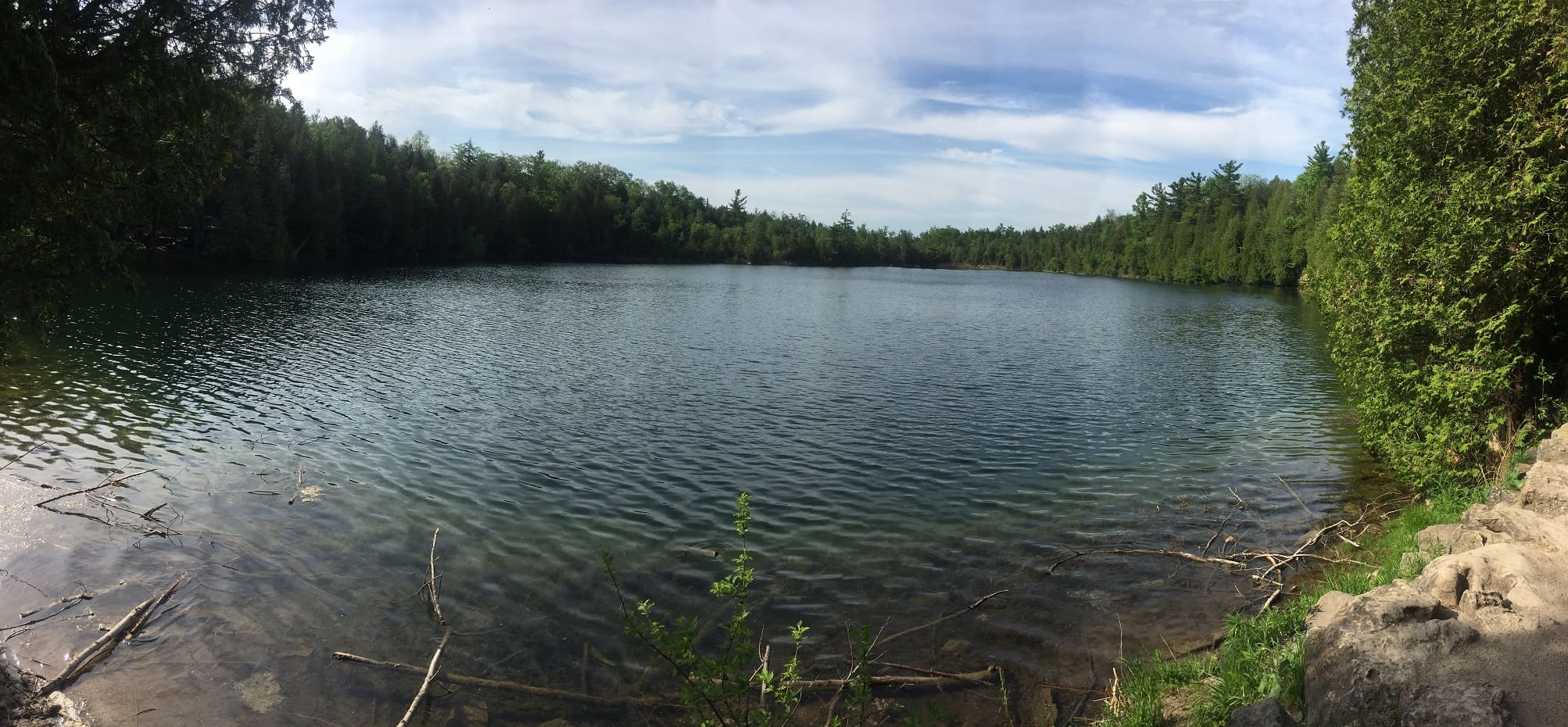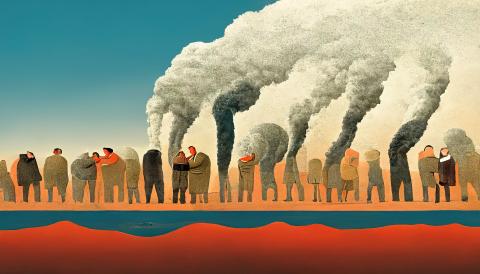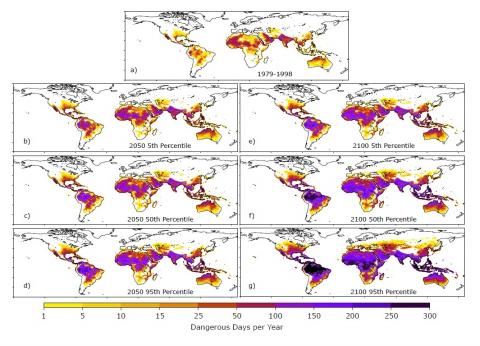Reactions to the proposal of Crawford Lake in Canada as a geological reference site for the Anthropocene
The Anthropocene Working Group of the International Commission on Stratigraphy has proposed Crawford Lake in Canada as a reference site for studying the Anthropocene as a possible geological epoch. This proposal for a Global boundary and Stratotype Section and Point (GSSP) was presented today at the International Congress of Stratigraphy in Lille, France. It is a necessary, but not sufficient step for the Anthropocene to enter the International Chronostratigraphic Table, the worldwide reference for geological units. Once approved by the AWG, this proposal has to go through three more votes in international geological bodies.

Crawford Lake (Canada). Photo credit: Sarah Roberts
Alejandro Cearreta - Crawford Lake EN
Alejandro Cearreta
Paleontologist at the University of the Basque Country UPV/EHU, director of the geology department and member of the former Anthropocene Working Group
The Anthropocene Working Group (AWG) was established by the Subcommission on Quaternary Stratigraphy to determine the validity of the Anthropocene as a new geological time and to propose its definition. Over the past 15 years it has evaluated physical, chemical and biological evidence preserved in the most recent sediments and rocks of our planet. Since 2019, a collaborative project between the AWG and the Haus der Kulturen der Welt and the Max Planck Institute for the History of Science (Germany) has been underway to analyse the most suitable sites that could host the stratotype marking the beginning of the Anthropocene. Most of the teams that submitted their proposals identified plutonium as their main indicator and proposed the start of the Anthropocene based on an increase in the signal of this (mostly) man-made radioactive element, found in sediments and rocks deposited across the planet since the early 1950s.
The AWG has finally selected Crawford Lake (Canada) as the site containing the reference sedimentary record to define the beginning of the Anthropocene. The sediments that accumulate at its bottom are formed by annual layers called lake varves. The layer proposed as a marker for the Anthropocene stratotype is found in a calcite sheet deposited in the summer of 1950 and was selected because of the rapid increase in plutonium thereafter. This signal also coincides with an increase in spheroidal carbonaceous particles (originating from the burning of fossil fuels at high temperatures) and a major ecosystem change identified by a decline in elm pollen and a replacement in the diatom species living in the lake.
The Anthropocene is part of geological time and, despite its short duration, will be recognised as the end of a relatively stable epoch in Earth's history, driven by an unprecedented increase in human population, energy consumption, industrialisation and globalisation following the end of World War II.
Conflict of interest: Member of the AWG.
Juan Carlos Gutiérrez Marco - Crawford Lake EN
Juan Carlos Gutiérrez Marco
CSIC geologist and paleontologist at the Institute of Geosciences (CSIC-UCM)
Is the selection supported by solid data?
"The data supporting the nomination are based on a series of short drilling holes taken at the bottom of a lake with exceptional conditions for recording all kinds of environmental fluctuations, and using state-of-the-art ultra-high resolution analytical techniques. It is a small lake, developed in a doline of karstic origin, with a maximum depth of 24 m, with stratified and oxygenated water, where varved sediments are deposited with remains of pollen and microorganisms that testify to geochemical and organic changes. Anthropocene sediments are restricted to the upper 10-13 cm of all boreholes, affected by all kinds of anthropogenic contaminants from a neighbouring highly industrialised region.
The work and site selection is sound: this half-span of Anthropocene sediments preserves all the stratigraphic indicators of a geologically changed horizon. Another matter is whether the formal range is that of an epoch. F,or example in the Devonian there are planetary-scale oceanographic events that occur within geological floors and are highly detectable; however, they do not mark formal geochronological boundaries. The history of the planet is a succession of geological changes and the Anthropocene is not geology. It is more like the old theological-philosophical concepts of the Anthropozoic era or the Anthropogenic period, which did not make it into geology because of their unscientific character.
Are there any major limitations to be taken into account?
"The boreholes provide an ideal sequence of events recorded in the sediments, which has taken many years to be found. But as a standard scale, the detection of such a small Anthropocene requires a sum of specialists and sophisticated technologies that do not make it cost-effective in any case. And then there are indicators that disappear over time, such as radioisotopes from nuclear explosions: the plutonium detected in some Lake Crawford shafts has a half-life of 24,100 years, and will cease to be detectable after 100,000 years, almost irrelevant on the geological scale.
What impact might this selection have (or not), for geology and beyond?
"Those of us who believe that the Anthropocene is a geological event, the result of the diachronic impact of human activity on our own ecosystem, are not in favour of giving it a start date, much less of formalising the term on a geological scale measured in thousands to millions of years, in order to create a forward-looking and ultimately guilt-ridden unit by trying to make it the geological expression of a global change of anthropogenic origin. This is why the Anthropocene should continue to be treated as a meta-concept that can be used by all kinds of thinkers, artists and scientists, and I find it ridiculous that a minority elite of geologists insist on putting the concept of the Anthropocene in the context of a global change of anthropogenic origin.”
Blanca Martínez - Crawford Lake EN
Blanca Martínez
Researcher in the geology department
Using a lake-bottom probe as a possible GSSP for the Anthropocene is a wise decision. Sedimentary records from lake environments are excellent tools (proxies) to analyse recent environmental changes with a high temporal resolution, as a new layer of sediment is deposited on lake bottoms every year and continuously for centuries or millennia. This makes it possible to give a precise age to the main geochemical indicator considered as a possible start of the Anthropocene, the radioactive Pb signal from atomic testing. Furthermore, having this record of human-induced environmental variations from one year to the next facilitates the correlation of geological records from around the world with a precision never before achieved in geology.
However, lake probes can have certain limitations. Lakes are very sensitive to environmental and climatic changes, recording not only global scale variations, but also local or regional scale variations, such as nearby fires, intentional modifications of water systems or human-induced alterations of fauna and flora. For this reason, it is necessary to have other possible secondary reference sections to identify, characterise and give a precise age to the changes that have occurred at a global scale, in order to separate their signals and evidence from local alterations.
This international meeting takes the geological discussion on the possible definition of the Anthropocene as a new temporal division of the Earth's history a step further. But its ratification is only a scientific matter. On a social level, it should serve as the presentation of new, solid and rigorous scientific evidence that humans are capable of altering the natural biogeochemical cycles of our planet through our actions, which are marked in sediments all over the world. Even if, for the time being, we are still living in the Upper Holocene.
Francine MG McCarthy et al.
- Research article
- Peer reviewed



